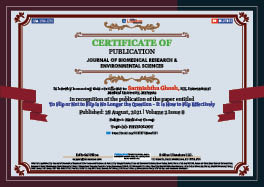> Medicine Group. 2021 August 28;2(8):713-714. doi: 10.37871/jbres1301.
To Flip or Not to Flip is No Longer the Question - It is How to Flip Effectively
Sarmishtha Ghosh*
Technological advancement and change of student attitude towards learning have brought in the necessity of blended learning which is now ubiquitous across medical and allied health sciences education. Flipped classroom forms an increasingly large part of this approach.
As the term states, Flipped Classroom means “inverted” classroom. Does that mean a physical inversion? No, it does not. It means the activities that take place within the four walls of a traditional classroom and activities that take place in the personal learning space of a student are reversed. The concept is nothing new, but it has evolved over the years, considering it’s usability and acceptability amongst students and lecturers.
Two teachers in Colorado, USA, Aaron Sams and Jonathan Bergmann designed a model resembling Flipped classroom in 2007, when they began recording their lessons and lectures and turned them into videos to be sent to students who were not able to attend actual class sessions. They called it “pre-broadcasting” and realized that this served as a learning method that could foster student-centered learning and autonomy, more flexible and effective. However, the concept of flipping the classroom can be traced back as early as 1993, when Allison King put forward the importance of use of class time for the construction of meaning rather than simply information transmission, thus reversing the educational space for active learning. It is realized that flipped classroom can help students spend their time to learn the theories and facts outside the classroom, and personalize learning in the classroom through discussion, inquiry, project work, role play, student’s presentation which are conducted in the classroom [1-5].
So, in the classroom activity, there is complex cognitive interchange between the teacher and the students as well as between students facilitated by the teacher. This prevents passive notetaking and listening to long lectures in the classroom, without active contribution from the students. The in-class activities demand that students participate more actively in discussing and clarifying their misconceptions or even contributing to peer teaching. The Self-Determination Theory (SDT) framework which comprise of students’ needs for competence, autonomy and relatedness support Flipped Classroom concept. When the students have the feeling of ability to complete a task, volition to perform a task, and have support from a group, they will feel effective and motivated.
Constructing a Flipped classroom requires careful and meticulous planning on the part of the instructor which begins with a clearly drafted lesson plan [1]. The success of flipped classroom strongly relies on preparation of the engaging and interesting instructional materials, substantial pre-class preparation by the students and optimum utilization of class time and student engagement by the facilitator [2]. This poses a number of challenges to the teachers.
The first challenge is the preparation and distribution of learning material. The reading materials provided usually follow a structured design consisting of introduction, content, assessment and a summary. It can be distributed in the form of videos, handouts, web lectures, text selections, scientific papers and books. Creation of videos requires a certain degree of technical expertise on the part of the teacher. However, this is not entirely true as freely available online videos and presentations can also be used. So facilitators can curate or co creates videos [3].
The second challenge is the optimum utilization of class time. This is the time when the facilitator needs to assess student preparation and initiate higher order thinking skills among the students and instill in them a sense of enquiry. The facilitator also needs to cater to individual student needs during this time. The face-to-face class session also maximizes student teacher and student peer interaction. The facilitator has to devote considerable amount of his or her time to design an effective plan for best utilization of class time [4,5].
During the past one year of COVID-19 pandemic when majority of learning has been shifted from physical face-to-face to virtual experience, the flipped classroom model, has gained more importance. The usual speculation of effectivity of flipped classroom remains as always but if implemented properly, this approach can be a promising alternative to traditional didactic lectures.
Numerous studies have been conducted on efficacy of flipped classroom which are contextual and describes the utility of this instructional approach which satisfies the student-centered learning but also use of inquiry driven learning strategies. Flipped learning need to take place with direct instruction moving from group learning space to individual learning space where factual learning takes place. Then, further contextualization takes place in a dynamic interactive group learning environment with educator’s guidance. The idea is not new but is readily evolving and becoming popular with students and educators.
Flipping the classroom is more about a mindset: redirecting attention away from the teacher and putting attention on the learner and the learning.
― Aaron Sams, Flip Your Classroom
References
- Long T, Cummins J, Waugh M. Use of the flipped classroom instructional model in higher education: instructors’ perspectives. Journal of computing in higher education. 2017;29(2):179-200. https://tinyurl.com/ku5c2s23
- Cotta KI, Shah S, Almgren MM, Moriarity LZ, Mody V. Effectiveness of flipped classroom instructional model in teaching pharmaceutical calculations. Currents in Pharmacy Teaching and Learning. 2016;8(5):646-53. https://tinyurl.com/2xhtw8yz
- Pierce R, Fox J. Vodcasts and active-learning exercises in a “flipped classroom” model of a renal pharmacotherapy module. Am J Pharm Educ. 2012 Dec 12;76(10):196. doi: 10.5688/ajpe7610196. PMID: 23275661; PMCID: PMC3530058.
- Cheng L, Ritzhaupt AD, Antonenko P. Effects of the flipped classroom instructional strategy on students’ learning outcomes: A meta-analysis. Educational Technology Research and Development. 2019;67(4):793-824. https://tinyurl.com/4esea9fx
- Shi Y, Ma Y, MacLeod J. College students’ cognitive learning outcomes in flipped classroom instruction: a meta-analysis of the empirical literature. J Comput Educ. 2020;7:79–103 https://tinyurl.com/45p3v5mz
Content Alerts
SignUp to our
Content alerts.
 This work is licensed under a Creative Commons Attribution 4.0 International License.
This work is licensed under a Creative Commons Attribution 4.0 International License.








